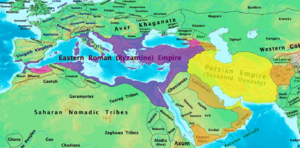
Back الغزو الساساني للقدس Arabic Eroberung von Jerusalem (614) German Sitio de Jerusalén (614) Spanish محاصره اورشلیم (۶۱۴) Persian Siège de Jérusalem (614) French כיבוש ירושלים בידי הפרסים HE Penaklukan Yerusalem oleh Sasaniyah ID サーサーン朝のエルサレム征服 Japanese Опсада на Ерусалим (614) Macedonian Beleg van Jeruzalem (614) Dutch
| Sasanian conquest of Jerusalem | |||||||||
|---|---|---|---|---|---|---|---|---|---|
| Part of the Byzantine–Sasanian War of 602–628 | |||||||||
 Territory controlled by the Byzantines (purple) and the Sasanians (yellow) in 600 CE | |||||||||
| |||||||||
| Belligerents | |||||||||
| Byzantine Empire |
Sasanian Empire Anti-Heraclian Jews | ||||||||
| Commanders and leaders | |||||||||
|
Heraclius Zacharias |
Khosrow II Shahrbaraz Nehemiah ben Hushiel Benjamin of Tiberias | ||||||||
| Strength | |||||||||
| Unknown |
Unknown number of Sasanians 20,000–26,000 Jewish rebels[1] | ||||||||
| Casualties and losses | |||||||||
| Disputed | Disputed | ||||||||
| Many Jews killed during the revolt; 4,518[2]–66,509 Christians killed during the siege[3] | |||||||||
The Sasanian conquest of Jerusalem in early 614 was a significant event in the Byzantine–Sasanian War of 602–628. After the conquest of Jerusalem and the defeat of the Byzantines, Khosrow II ordered to transfer the true cross to Tisophon.
Amidst the conflict, Sasanian king Khosrow II had appointed Shahrbaraz, his spahbod (army chief), to lead an offensive into the Diocese of the East of the Byzantine Empire. Under Shahrbaraz, the Sasanian army had secured victories at Antioch as well as at Caesarea Maritima, the administrative capital of Palaestina Prima.[4]: 206 By this time, the grand inner harbour had silted up and was useless, but the city continued to be an important maritime hub after Byzantine emperor Anastasius I Dicorus ordered the reconstruction of the outer harbour. Successfully capturing the city and the harbour had given the Sasanian Empire strategic access to the Mediterranean Sea.[5] The Sasanians' advance was accompanied by the outbreak of a Jewish revolt against Heraclius; the Sasanian army was joined by Nehemiah ben Hushiel[6] and Benjamin of Tiberias, who enlisted and armed Jews from across Galilee, including the cities of Tiberias and Nazareth. In total, between 20,000 and 26,000 Jewish rebels took part in the Sasanian assault on Jerusalem.[7][1] By mid-614, the Jews and the Sasanians had captured the city, but sources vary on whether this occurred without resistance[4]: 207 or after a siege and breaching of the wall with artillery. Following the Sasanians capture of Jerusalem tens of thousands of Byzantine Christians were massacred by the Jewish rebels.
- ^ a b James Parkes (1949). A history of Palestine from 135 A.D. to modern times. Victor Gollancz. p. 81.
- ^ Cite error: The named reference
Avniwas invoked but never defined (see the help page). - ^ Cite error: The named reference
Antiochuswas invoked but never defined (see the help page). - ^ a b Thomson, R. W.; Howard-Johnston, James (historical commentary); Greenwood, Tim (assistance) (1999). The Armenian History Attributed to Sebeos. Liverpool University Press. ISBN 978-0-85323-564-4. Retrieved 17 January 2014.
- ^ Joseph Patrich (2011). "Caesarea Maritima". Institute of Archaeology Hebrew University of Jerusalem. Retrieved 13 March 2014.
- ^ Haim Hillel Ben-Sasson (1976). A History of the Jewish People. Harvard University Press. p. 362. ISBN 978-0-674-39731-6. Retrieved 19 January 2014.
nehemiah ben hushiel
- ^ Kohler, Kaufmann; Rhine, A. [Abraham Benedict] (1906). "Chosroes (Khosru) II. Parwiz ("The Conqueror")". Jewish Encyclopedia. Retrieved 20 January 2014.